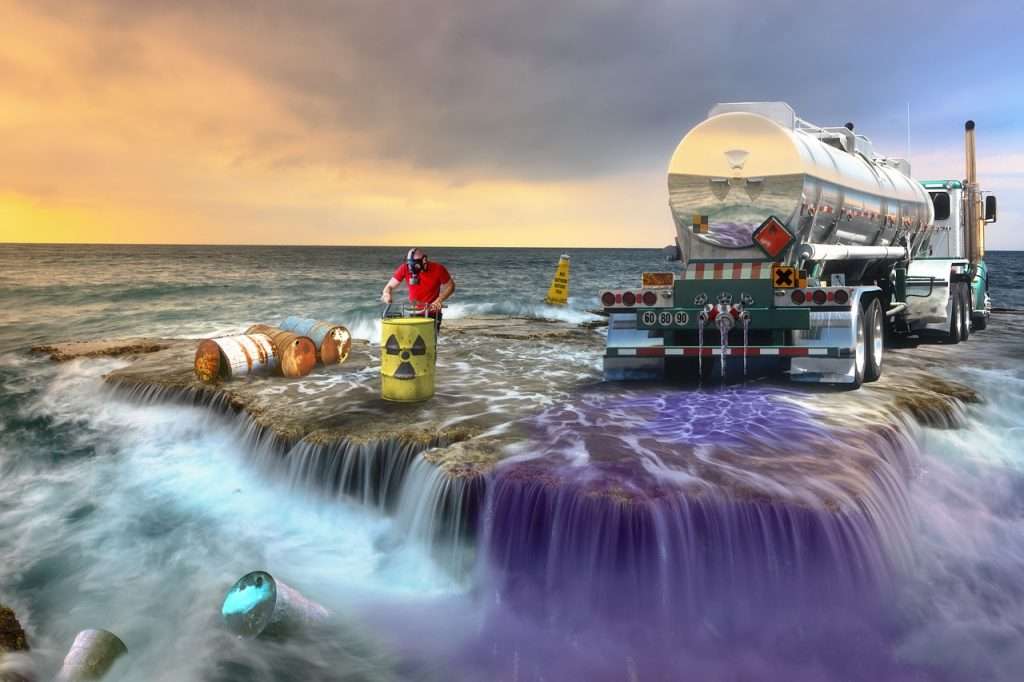One of the most urgent issues of our time is the harm to the environment and environmental crime. The term “environmental harm” describes the harm done to the environment, which may have an immediate effect on people’s health and well-being. Environmental crime is defined as actions that endanger the environment while breaking environmental laws and regulations. In this article, we will define environmental harm and environmental crime, and discuss the recognition of the right to a safe environment as a human right and its legal consequences.
Environmental Harm
Environmental harm is a serious issue that affects the natural world and human well-being. Any harm to the environment caused by human activity is referred to as environmental harm. This can take many forms, including pollution, destruction of natural habitats, and overuse of resources.
The Merriam-Webster dictionary defines environmental harm as “physical injury, damage, or destruction to land, air, water, or wildlife” caused by human activity. According to the Oxford Dictionary of Law, environmental injury is a broader term that encompasses the negative effects of environmental harm on human health and well-being. This can include damage to air, water, soil, flora, or fauna, as well as the physical or cultural environment. Environmental injury can have both short-term and long-term impacts, which can range from property damage and accidents to the loss of biodiversity and environmental deterioration.
Environmental harm is a serious issue that needs to be addressed on a worldwide scale. To lessen the consequences of human activities on the environment, governments all over the world have put environmental protection laws and regulations into place. The Clean Water Act and the Clean Air Act are two examples of federal laws in the United States that are intended to safeguard the environment. Similarly to this, the Environmental Liability Directive adopted by the European Union makes companies accountable for any environmental harm they may have caused.
The United States defines environmental harm under the Comprehensive Environmental Response, Compensation, and Liability Act (CERCLA) as “any damage or destruction of natural resources, including the loss of profits from such resources, resulting from exposure to hazardous substances released into the environment”. This definition encompasses harm caused to air, water, soil, flora, or fauna, and includes both short-term and long-term effects.
The European Union defines environmental harm as “an impairment of or damage to the quality of the environment, including the health and safety of humans, flora, fauna and ecosystems, the values of cultural sites and built structures or any other aspect of the environment”. This definition includes harm caused to cultural sites and built structures in addition to the natural environment.
In Bangladesh, the Environmental Conservation Act of 1995 defines environmental pollution and harm. The Act defines environmental harm as “any adverse effect on the environment, including harm to human health, damage to flora or fauna, impairment of ecosystem functions, and interference with other legitimate uses of the environment, caused by an environmental pollutant.” The definition encompasses a wide range of environmental harm caused by pollutants and highlights the importance of preventing such harm to protect the environment and human health.
This Act also defined environmental pollution and environmental pollutant. According to Section 2 of the Act, environmental pollution is defined as “the presence or introduction into the environment of any environmental pollutant that may cause harm to any living organisms or non-living things.” An environmental pollutant is defined as “any substance, whether in solid, liquid, or gaseous form, which if introduced into the environment, is liable to create a nuisance, or to cause harm to any living organisms or non-living things.”
Read What is Environmental Crime? Discuss its types, impacts, and steps to way out.
It’s important to note the actions the Bangladeshi government has done to address environmental concerns and stop environmental harm. To prevent pollution, protect natural resources, and encourage sustainable development, the government has implemented a number of regulations and programs. It is essential that the Environmental Conservation Act and other relevant rules and regulations be upheld in order to guarantee that people and organizations do not harm the environment and are held responsible for any such harm.
Types of Environmental harm
Environmental harm is the term for when the environment is harmed or damaged as a result of human activity, a natural disaster, or a combination of the two. On the environment and human health, environmental harm can have both immediate and long-term effects. Creating effective policies and legal frameworks to address these concerns requires an understanding of the various types of environmental harm.
In this context, we might roughly classify environmental harm into a number of different forms, such as pollution, deforestation, biodiversity loss, climate change, and resource misuse. Environmental harm comes in a variety of forms, each having unique traits and effects on the environment and society. Each of these categories has a huge environmental impact and needs urgent attention to stop additional harm.
Pollution
One of the most prevalent types of environmental harm is pollution. The ecosystem and human health may be negatively impacted by the release of dangerous compounds into the air, water, or soil. Numerous activities, such as transportation, the burning of fossil fuels, and industrial pollutants, can contribute to pollution. Among the frequent forms of contamination are:
Air pollution
This is the dispersion of hazardous materials into the atmosphere, which can lead to respiratory conditions and accelerate climate change. Transportation, industrial pollutants, and the burning of fossil fuels are all sources of air pollution.
Water pollution
This is when dangerous compounds are released into bodies of water including rivers, lakes, and seas. These pollutants can damage aquatic ecosystems, degrade the water’s quality, and endanger both people’s and wildlife’s health. Industrial waste, agricultural runoff, and sewage discharge are all sources of water contamination.
Soil pollution
This is the release of poisonous compounds into the soil, which can have a negative impact on the health of people, plants, and the soil itself. Hazardous waste disposal, agricultural practices, and industrial operations are some of the sources of soil pollution.
Destruction of Natural Habitats
Another form of environmental harm is the destruction of natural ecosystems. It refers to the destruction of natural ecosystems, which may have a negative impact on ecosystem services and biodiversity. Numerous actions, such as deforestation, urbanization, and agricultural methods, can result in the degradation of natural ecosystems.
Deforestation
Forests are being cut down for industrial or commercial objectives. Deforestation may negatively impact local communities that depend on forests for their livelihoods as well as biodiversity and carbon sequestration.
Urbanization
Urban regions are being developed through the construction of buildings and infrastructure in this process. Natural habitat destruction, biodiversity loss, and increasing pollution are all effects of urbanization.
Agricultural practices
Aggressive farming methods like monoculture are among them. These practices can cause soil degradation, biodiversity loss, and water contamination.
Define Environmental law. What are the major sources of environmental law?
Overuse of Resources
Overuse of resources also harms the environment. It refers to the diminishing supply of natural resources like water, minerals, and fossil fuels, which may have a negative impact on society and the environment. Numerous activities, such as industrial processes, transportation, and excessive consumption, can lead to resource overuse.
Industrial activities
These include the mining of minerals and the burning of fossil fuels, which can deplete natural resources and harm the ecosystem.
Transportation
These cover using cars for the transportation of people and products, which can lead to air pollution and the depletion of fossil fuels.
Overconsumption
When people or communities consume resources excessively, it can cause the depletion of natural resources and environmental devastation.
Examples of Environmental Harm
Oil Spills
Oil spills are a common form of environmental damage that can seriously harm both the environment and people. When oil leaks into the environment, such as during an oil tanker disaster or offshore drilling, it creates an oil spill. The oil can taint drinking water sources, injuring marine life, and destroy habitats.

The 1989 Exxon Valdez oil leak is among the most well-known cases of an oil spill. Thousands of birds, fish, and other marine animals perished as a result of the oil leak in Alaska. The local fishing sector, which was forced to close down as a result of the tainted fish stocks, was also significantly impacted.
Deforestation
Another form of environmental harm that has become more prevalent in recent years is deforestation. When forests are cut down for logging, agriculture, or urban development, deforestation results. This may have a substantial effect on the environment since it may result in changes to weather patterns, soil erosion, and biodiversity loss.
The destruction of the Amazon rainforest is one of the most notable instances of deforestation. Due to its role in collecting carbon dioxide from the atmosphere, the Amazon is frequently referred to as the “lungs of the Earth” and is home to a sizable amount of the world’s biodiversity. The destruction of the Amazon rainforest can result in the release of massive amounts of carbon dioxide into the atmosphere, which will exacerbate climate change.
Water Contamination
Another type of environmental harm that has a big effect on people’s health is water contamination. Agricultural runoff, sewage discharge, and industrial waste are just a few of the many sources that can contaminate water. The spread of waterborne illnesses like cholera, typhoid, and hepatitis A can be attributed to contaminated water.
The Flint water crisis in Michigan, USA, is one evidence of water contamination. The city of Flint shifted from using Lake Huron as its water source to the Flint River in 2014. Due to the Flint River’s highly corrosive water and the lead that it leached from the city’s pipes; the city’s drinking water was severely contaminated. As a result, thousands of residents were exposed to lead-contaminated water, resulting in a serious public health disaster.
The Impact of Environmental Harm
Harm to the environment can have a serious effect on people’s health, the economy, and society as a whole. The consequences on the environment and the people who depend on it may be both direct and indirect, and they may last a long time.
Health Effects
Human health can be significantly impacted by environmental harm. Numerous health issues, including cancer, neurological diseases, and respiratory issues, can be brought on by exposure to pollution and poisons. Vulnerable populations, such as children, the older, and those with pre-existing medical disorders, may be particularly affected.
Economic Effects
The economy may be significantly impacted by environmental harm. Significant financial consequences, such as lost tourism revenue and the expense of repairing environmental damage, can result from the depletion of natural resources and their effects on the environment. Industries that depend on natural resources, including forestry and fisheries, can also be significantly impacted by environmental devastation.
Social Effects
Harm to the environment can also have a big effect on society as a whole. Cultural and spiritual activities, as well as the quality of life for those whose livelihoods depend on the environment, can be impacted by the loss of natural habitats and biodiversity. Due to the possibility that vulnerable people may be more susceptible to the effects of environmental deterioration, environmental harm might also exacerbate already existing social inequities.
As a result of human activity, natural disasters, or a combination of both, environmental harm is the injury or destruction of the environment. Some of the most frequent forms of environmental harm include pollution, habitat destruction, and resource abuse. To ensure the sustainable use of natural resources and the preservation of the environment for future generations, it is crucial to understand and address the causes and effects of environmental harm.
Protection of the environment: Who is responsible?
Environment protection and preservation are key concerns that call for the cooperation and dedication of people, organizations, and governments on local, national, and international scales. While individuals can help safeguard the environment by forming eco-friendly habits, it is the duty of organizations and governments to create and enforce laws and regulations to stop and lessen environmental harm.
Regarding responsibility, several nations have set up authorities or agencies for environmental protection, whose job it is to supervise and enforce environmental laws. For instance, in the US, the Environmental Protection Agency (EPA) is in charge of enforcing environmental regulations in order to preserve human health and the environment.
In addition to the government, private firms and industries are responsible for protecting the environment. They may do this by putting sustainable practices and technologies in place to decrease their impact on the environment. Many firms are also required to adhere to environmental regulations, and failing to do so may result in fines, legal action, and reputational damage.
Overall, everyone involved must work together to protect the environment. It is critical to establish and implement strict environmental rules, advance sustainable business models, and motivate people to live environmentally responsible lives. Together, we can make sure that our world continues to be a livable place for future generations.
Measures to protect and conserve the environment
A cooperative effort from all stakeholders is necessary to protect and safeguard the environment from harm. To prevent and alleviate environmental harm, people, governments, and organizations can adopt a variety of administrative and legal actions. With the help of these actions, legal frameworks, rules, and regulations can be established to address environmental problems including pollution, biodiversity loss, and climate change.
The adoption and implementation of environmental laws and regulations are one of the most important legal measures. These regulations can address a variety of challenges, such as managing hazardous waste, protecting wildlife, and maintaining biodiversity. It is crucial to establish environmental agencies and assign personnel in charge of carrying out and upholding environmental laws and regulations.
Read What is Environmental law? How does it differ from other branches of law?
Legal measures can be complemented by administrative ones to further the cause of sustainability. The creation of environmental standards, the creation of environmental management systems, and certification programs that honor and reward sustainable practices are a few examples of these actions.
Public involvement and education are also essential in advancing environmental protection. Public knowledge and support for environmental preservation activities can be raised through awareness campaigns, community outreach programs, and environmental education projects.
Overall, securing and protecting the environment from harm requires a combination of legislative and administrative measures, public involvement, and education. Governments, organizations, and people must all assume responsibility for protecting the environment and cooperate to do so for the sake of coming generations.
The authority should do further to maintain, protect, and conserve the environment by legal and administrative means. In order to do this, it’s essential to reduce greenhouse gas emissions, conserve energy and water, support sustainable forestry and agricultural practices, and reduce waste and pollution. To lessen the negative effects of human activity on the environment, these actions can be taken at the individual, community, national, and international levels.
Reduce greenhouse gas emissions
Reducing greenhouse gas emissions is one of the most important actions that can be taken to safeguard the environment. In place of fossil fuels, this can be accomplished by turning to greener, more sustainable energy sources like solar, wind, or hydroelectricity. Energy and water conservation are also essential because they lower resource demand and lessen the negative environmental effects of resource extraction and use.
Promoting sustainable agriculture and forestry
Promoting environmentally friendly agricultural and forestry practices is yet another critical step in environmental protection. Using farming and forestry methods that encourage healthy ecosystems, lessen the use of hazardous chemicals, and reduce the impact on natural resources are part of this. Using sustainable techniques also includes defending endangered animals and preserving biodiversity.
Reducing waste and pollution
Environmental protection also depends heavily on reducing waste and pollution. Utilizing eco-friendly products, cutting back on the usage of plastic and other non-biodegradable materials, and recycling or composting garbage are all ways to accomplish this. Governments and businesses can also take action to control pollution and reduce how much of impact industrial operations have on the environment.
Do we need a mechanism to punish the perpetrator?
It is impossible to ensure the measures without bringing the perpetrator to justice. The authority must establish a system of punishment for those who harm the environment in order to ensure its protection and conservation.
Legal regimes frequently offer criminal and civil consequences to persons who harm the environment or commit environmental crimes. Penalties for crimes may include fines, incarceration, or other punishments. On the other hand, civil remedies frequently involve requesting monetary compensation or injunctions to stop harming.
Additionally, there are international institutions in place to deal with environmental crime and injury. For instance, the International Court of Justice and the International Criminal Court, both of which have jurisdiction over environmental crimes committed in member nations, were formed by the United Nations.
Additionally, there are international treaties and accords that set worldwide commitments and processes for resolving environmental degradation, such as the Paris Agreement on climate change. However, it can be difficult to enforce environmental rules and regulations, particularly in areas with weak governments or high levels of corruption.
The duty for preserving the environment and taking action to lessen human impact on the environment rests with everyone, from individuals to governments Therefore, attempts to promote environmental protection frequently require lobbying, education, as well as cooperation between governments, civil society organizations, and the commercial sector, in addition to legislative systems. We can assure a sustainable future for ourselves and future generations by banding together.















